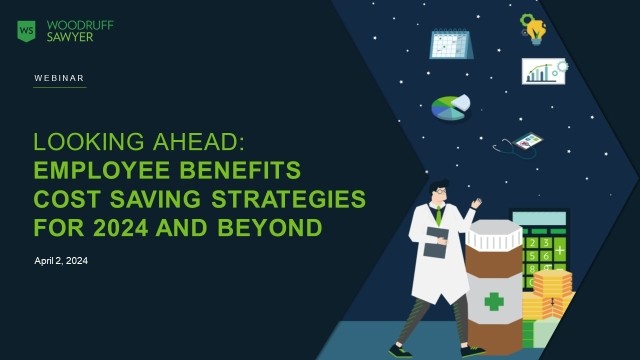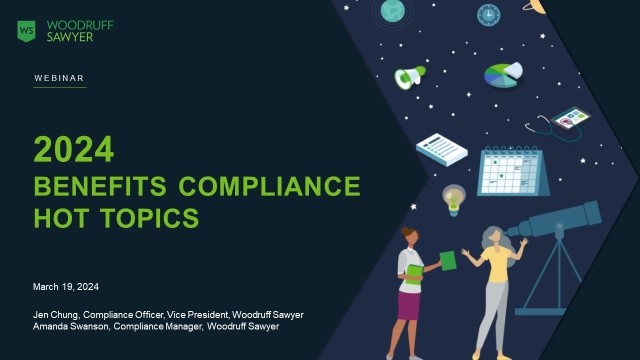Guide
Looking Ahead, Part 1: The Silver Lining for Employee Benefits in 2021
This is the first in a series of four articles comprising our Looking Ahead Guide to Employee Benefits in 2021, helping clients to set the stage for new opportunities in their Employee Benefits programs.
The year 2020 was certainly a year of unknown territory. We had no way of knowing the level of disruption we would experience personally, in business, or globally. However, we believe that challenging times are also learning opportunities as we take valuable lessons learned in employee benefits into the new year.

Why Was 2020 So Challenging?
Over the past year, everything was new. Everything was stressful.
According to neuroplasticity expert Dr. Andrew Huberman, we are in a deep period of uncertainty with many new decisions to make every day, and our brains must answer three questions for everything we do. How long will it take? How do I get there? What will be the outcome of my decision?
“It used to be you’d get up, you’d brush your teeth, you’d check your phone, you’d tackle your day. Now, you need to think about whether or not you can touch a door handle, how you’re going to get groceries. There’s a lot more planning … we’re thinking a lot harder about stuff that we just didn’t have to think about before.”
– Dr. Andrew Huberman
Isn’t that the truth? We went from autopilot to wondering about the outcome of every decision. No wonder we’re tired!
Want to get up to speed on-the-go? Listen to our podcast for this Looking Ahead blog post, featuring our interview with Melanie Sergejeff at Maintex on the challenges and the solutions they implemented:
[audio mp3="/sites/default/files/wp-content/2021/01/Mix_both_audio_mixdown_v2.mp3"][/audio]
Did Employee Benefits Strategy Get Thrown Out the Window?
“Everyone has a strategy until they get punched in the mouth.”
– Mike Tyson
Rapid change required our clients to evaluate what path they were on, originally based on 2019 economic conditions. March 2020 required everyone to quickly pivot based on circumstances no one ever encountered or predicted. We all experienced the panic of the pandemic, doing the best we could as the ground shifted beneath us.
Our clients experienced a dramatic shift in their employee models, requiring a shift in their employee benefits strategy. Some companies shifted to a partial if not entirely remote-based workforce, changing their policies, procedures, and technology to support their workforce while continuing to serve customers.
Clients with essential or frontline workers created new business models focused on keeping employees and customers safe while delivering routine services like healthcare, retail, grocery, or food service.
Still other companies were faced with an unpredictable future where they continued to support furloughed workers by staying engaged and providing benefits while keeping an eye on an uncertain future.
And some clients had all three employee models that included remote, onsite, and furloughed workers. The employee benefits market responded with forward-thinking plans that supported these new employee models, becoming more flexible on plan design, costs, eligibility, and enrollment dates. Carriers, clients, and consultants embraced creativity, all in an effort to keep employees supported while watching the employer’s bottom line.
Your 2020 benefits strategy might have gone by the wayside in order to focus on more immediate business needs, but the pandemic spurred creative strategies that offer innovative solutions to support our new economic realities. For 2021, new benefit programs include health, dental, mental health, financial wellness and more—supporting your employees and their families with a whole-person benefits approach.
We at Woodruff Sawyer have put together this Employer’s Return to Work Toolkit to help employers build their own action plan for returning employees to work after COVID-19.
Employee Benefits Help People Be More Resilient
“We should all be congratulating ourselves every morning. We’re still alive, we’re breathing, we’re winning.”
– Dr. Andrew Huberman, Neuroscientist
Despite uncertainty, sheltering in place, new family and educational routines, and concerns over our health, we’re still here. We’re still supporting each other. We have faced a range of emotions we’ve never seen before and kept going.
Our clients showed us that they needed to connect with employees beyond a Zoom call, giving new meaning to the term “employee engagement.” Employees have always needed to know that their employer cares about them. In 2020, employers and employees demonstrated a new type of engagement as they showed genuine concern and caring for everyone in the organization.
Working from home presents a unique set of challenges, from work spaces to sleep schedules: Read these WFH tips for helping your employees keep focused and at ease
In recent years, innovative wellness programs were a way to improve employee engagement. Now, they have become a cultural imperative. Companies who invested in their employees’ wellness in recent years turned to those programs during the pandemic, offering needed physical, mental, and emotional assistance to employees. Wellness programs are now a vital part of employee benefits as employers create an extensive support network for their workforce and their families.
A critical part of this support network comes in the form of mental health benefits as mental health issues rose to the forefront as a deep and common problem that we can no longer avoid. Our clients turned to us to promote mental and emotional health programs that helped employees and their families deal with escalating stress and the resulting health impacts.
In addition to benefits, carriers and communities offered resources like drive-through COVID-19 testing, PPE, homework assistance and flu shots, employers were the vital link between employees and these resources. Whether it came in the form of emails, a COVID portal on their website, or other communication channel, employers were the gateway to providing a wealth of resources (often cost-neutral) that supported their employees and families.
Despite our problems, employers stepped up to support their workforce. As individuals, we learned to empathize with each other, which was perhaps the biggest lesson of all. Benefit programs of tomorrow can no longer be “check the box” medical/dental/vision. There will be a host of additional smaller benefits that will be meaningful in different ways to your workforce.
Investing in Employees Today and Tomorrow
“The American miracle, the American magic, has always prevailed and it will do so again.”
– Warren Buffet
Employers faced complex, bottom-line terrifying uncertainty in 2020. The first reaction was to cut their largest expenses: labor and employee benefits. It was a natural reaction and traditional approach to uncertainty and conservation of resources.
With that uncertainty came a desire to play it safe and make no changes to benefit programs if possible. There is safety in what you know. However, the market has now shifted and the question you must ask yourself and your organization - will you pivot to meet your employee needs?
The workforce changes spurred by this pandemic will be long lasting. While it happened quickly, these changes will not be going away once a vaccine has been administered to the masses.
Our lesson is that we have to meet employees where they are. Their demographics (age, gender, location, role) are still influential. But new factors like the employer’s changing business model, mental health needs for the employee and their family, their personal financial situation, and similar variables must now be part of the solution.
That is not just the silver, but the gold lining we are seeing for our clients at Woodruff Sawyer. There has never been a better time to invest in benefits that not only retain and attract employees, but support them in times of crisis.
Employers have never played a bigger role in their employees’ lives. Employees now broadcast from their home office, put their health on the line to serve customers, and are more dependent on benefits to get them through this challenging time. Employers can embrace this as an opportunity, communicating more frequently, showing their appreciation, and offering a network of benefits that provide support that goes beyond just a paycheck.
Here at Woodruff Sawyer, we embraced COVID-19 challenges and developed new programs and benefits to keep employees focused, productive, and healthy.
At some point, the economy will come back. And so will the need for talented employees and the benefits you need to attract and retain them. Starting now, you can secure innovative plans that optimize your bottom line, support your employees’ health, and secure your talent for your future growth.
What Woodruff Sawyer is Doing Differently
The year 2020 taught us that client communication has never been more important. Our clients turned to us with every type of employee benefit plan question, helping them to make tough decisions.
Answering those questions required difficult conversations. We expect that 2021 will require more challenging conversations. But we are prepared to help our clients solve the difficult and complex issues they face as our business environment continues to evolve.
We will be reaching out to our clients more frequently and that may look/feel differently than it has in the past. Our benefits consultants will be working to incorporate the tactics and lessons learned during this pandemic to create new long-term strategic plans; helping employers balance the bottom line with more comprehensive employee benefit offerings.
What to Do Next with Employee Benefits
We will all be happy to see 2020 behind us. But as we begin to peek around the corner, we also need to take the lessons of strategy, empathy, and opportunity forward with us. What can you do now to embrace what’s next?
Commit to connect with your employees on the communication channel of their choice.
Make a news year's resolution to connect. You need to have an omni channel approach that connects with employees using their preferred methods. Mobile-enabled websites with detailed information for Millennials and younger, brochures for baby-boomers, and emails for everyone. Have the right channels in place to communicate effectively.
Employers today need to create benefit plans that suit the varied needs of a multi-generational workforce.
Think of your company benefits like part of an ongoing public relations project; Employee Benefits aren’t a once-and-done event. Your most valuable investment requires a consistent approach that helps them become familiar with your offerings. Emails, webcasts, invited speakers, and more can be part of your ongoing communication. Employees need to know what is available before they need benefits, not after a situation has occurred.
Reclaim and Remake Your Strategy
It’s a new year and time for a new strategy. You have the tools and the lessons learned from 2020 to move forward. Make a list - before you forget! What worked and what didn’t? What did you procrastinate about due to resources and/or information and what would you like to see done in the near future.
Woodruff Sawyer employee benefits consultants are ready to help you have a year that you will look forward to because your benefits will be in alignment with where you're headed in 2021 and beyond.
Table of Contents








